Michele Rossi
Convolutional Spiking-based GRU Cell for Spatio-temporal Data
Oct 29, 2025Abstract:Spike-based temporal messaging enables SNNs to efficiently process both purely temporal and spatio-temporal time-series or event-driven data. Combining SNNs with Gated Recurrent Units (GRUs), a variant of recurrent neural networks, gives rise to a robust framework for sequential data processing; however, traditional RNNs often lose local details when handling long sequences. Previous approaches, such as SpikGRU, fail to capture fine-grained local dependencies in event-based spatio-temporal data. In this paper, we introduce the Convolutional Spiking GRU (CS-GRU) cell, which leverages convolutional operations to preserve local structure and dependencies while integrating the temporal precision of spiking neurons with the efficient gating mechanisms of GRUs. This versatile architecture excels on both temporal datasets (NTIDIGITS, SHD) and spatio-temporal benchmarks (MNIST, DVSGesture, CIFAR10DVS). Our experiments show that CS-GRU outperforms state-of-the-art GRU variants by an average of 4.35%, achieving over 90% accuracy on sequential tasks and up to 99.31% on MNIST. It is worth noting that our solution achieves 69% higher efficiency compared to SpikGRU. The code is available at: https://github.com/YesmineAbdennadher/CS-GRU.
* 6 pages, 1 figure. Published in 2025 IEEE International Workshop On Machine Learning for Signal Processing, Aug. 31-Sep. 3, 2025, Istanbul, Turkey
ADMM-Based Training for Spiking Neural Networks
May 08, 2025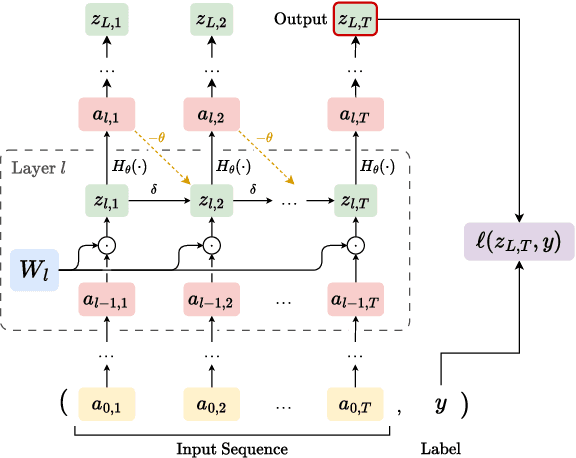
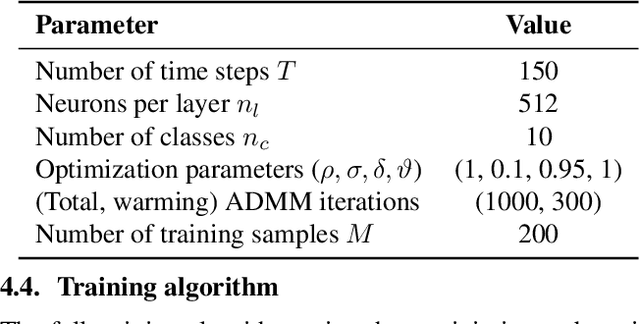
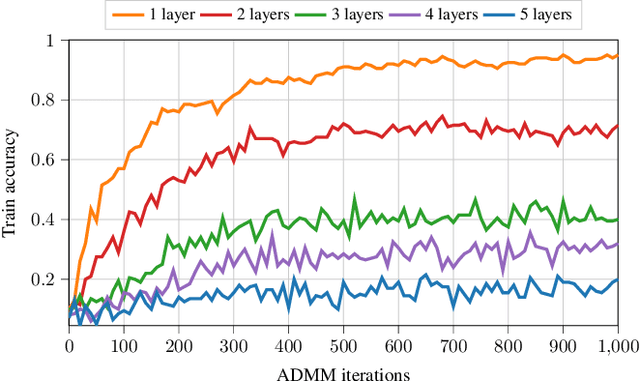
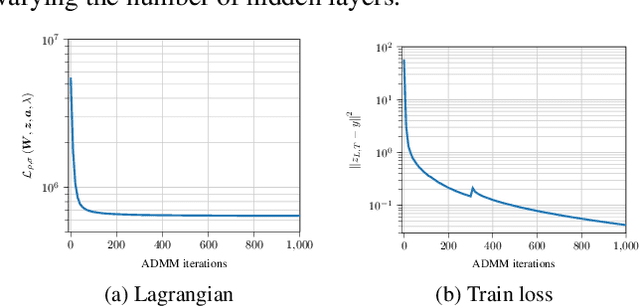
Abstract:In recent years, spiking neural networks (SNNs) have gained momentum due to their high potential in time-series processing combined with minimal energy consumption. However, they still lack a dedicated and efficient training algorithm. The popular backpropagation with surrogate gradients, adapted from stochastic gradient descent (SGD)-derived algorithms, has several drawbacks when used as an optimizer for SNNs. Specifically, it suffers from low scalability and numerical imprecision. In this paper, we propose a novel SNN training method based on the alternating direction method of multipliers (ADMM). Our ADMM-based training aims to solve the problem of the SNN step function's non-differentiability. We formulate the problem, derive closed-form updates, and empirically show the optimizer's convergence properties, great potential, and possible new research directions to improve the method in a simulated proof-of-concept.
LightSNN: Lightweight Architecture Search for Sparse and Accurate Spiking Neural Networks
Mar 27, 2025Abstract:Spiking Neural Networks (SNNs) are highly regarded for their energy efficiency, inherent activation sparsity, and suitability for real-time processing in edge devices. However, most current SNN methods adopt architectures resembling traditional artificial neural networks (ANNs), leading to suboptimal performance when applied to SNNs. While SNNs excel in energy efficiency, they have been associated with lower accuracy levels than traditional ANNs when utilizing conventional architectures. In response, in this work we present LightSNN, a rapid and efficient Neural Network Architecture Search (NAS) technique specifically tailored for SNNs that autonomously leverages the most suitable architecture, striking a good balance between accuracy and efficiency by enforcing sparsity. Based on the spiking NAS network (SNASNet) framework, a cell-based search space including backward connections is utilized to build our training-free pruning-based NAS mechanism. Our technique assesses diverse spike activation patterns across different data samples using a sparsity-aware Hamming distance fitness evaluation. Thorough experiments are conducted on both static (CIFAR10 and CIFAR100) and neuromorphic datasets (DVS128-Gesture). Our LightSNN model achieves state-of-the-art results on CIFAR10 and CIFAR100, improves performance on DVS128Gesture by 4.49%, and significantly reduces search time, most notably offering a 98x speedup over SNASNet and running 30% faster than the best existing method on DVS128Gesture.
Open-Set Gait Recognition from Sparse mmWave Radar Point Clouds
Mar 10, 2025Abstract:The adoption of Millimeter-Wave (mmWave) radar devices for human sensing, particularly gait recognition, has recently gathered significant attention due to their efficiency, resilience to environmental conditions, and privacy-preserving nature. In this work, we tackle the challenging problem of Open-set Gait Recognition (OSGR) from sparse mmWave radar point clouds. Unlike most existing research, which assumes a closed-set scenario, our work considers the more realistic open-set case, where unknown subjects might be present at inference time, and should be correctly recognized by the system. Point clouds are well-suited for edge computing applications with resource constraints, but are more significantly affected by noise and random fluctuations than other representations, like the more common micro-Doppler signature. This is the first work addressing open-set gait recognition with sparse point cloud data. To do so, we propose a novel neural network architecture that combines supervised classification with unsupervised reconstruction of the point clouds, creating a robust, rich, and highly regularized latent space of gait features. To detect unknown subjects at inference time, we introduce a probabilistic novelty detection algorithm that leverages the structured latent space and offers a tunable trade-off between inference speed and prediction accuracy. Along with this paper, we release mmGait10, an original human gait dataset featuring over five hours of measurements from ten subjects, under varied walking modalities. Extensive experimental results show that our solution attains F1-Score improvements by 24% over state-of-the-art methods, on average, and across multiple openness levels.
HiSAC: High-Resolution Sensing with Multiband Communication Signals
Jul 09, 2024



Abstract:Integrated Sensing And Communication (ISAC ) systems are expected to perform accurate radar sensing while having minimal impact on communication. Ideally, sensing should only reuse communication resources, especially for spectrum which is contended by many applications. However, this poses a great challenge in that communication systems often operate on narrow subbands with low sensing resolution. Combining contiguous subbands has shown significant resolution gain in active localization. However, multiband ISAC remains unexplored due to communication subbands being highly sparse (non-contiguous) and affected by phase offsets that prevent their aggregation (incoherent). To tackle these problems, we design HiSAC, the first multiband ISAC system that combines diverse subbands across a wide frequency range to achieve super-resolved passive ranging. To solve the non-contiguity and incoherence of subbands, HiSAC combines them progressively, exploiting an anchor propagation path between transmitter and receiver in an optimization problem to achieve phase coherence. HiSAC fully reuses pilot signals in communication systems, it applies to different frequencies and can combine diverse technologies, e.g., 5G-NR and WiGig. We implement HiSAC on an experimental platform in the millimeter-wave unlicensed band and test it on objects and humans. Our results show it enhances the sensing resolution by up to 20 times compared to single-band processing while occupying the same spectrum.
Bistatic Doppler Frequency Estimation with Asynchronous Moving Devices for Integrated Sensing and Communications
Mar 21, 2024



Abstract:In this letter, we present for the first time a method to estimate the bistatic Doppler frequency of a target with clock asynchronous and mobile Integrated Sensing And Communication (ISAC) devices. Existing approaches have separately tackled the presence of phase offsets due to clock asynchrony or the additional Doppler shift due to device movement. However, in real ISAC scenarios, these two sources of phase nuisance are concurrently present, making the estimation of the target's Doppler frequency particularly challenging. Our method solves the problem using the sole wireless signal at the receiver, by computing Channel Impulse Response (CIR) phase differences across different multipath components and subsequent time instants. In this way, we cancel out phase offsets. Then, we construct a system of equations that allows disentangling the target's Doppler frequency from that of the moving device. The proposed method is validated via simulation, exploring the impact of different system parameters. Numerical results show that our approach is a viable way of estimating Doppler frequency in bistatic asynchronous ISAC scenarios with mobile devices.
Sensing in Bi-Static ISAC Systems with Clock Asynchronism: A Signal Processing Perspective
Feb 14, 2024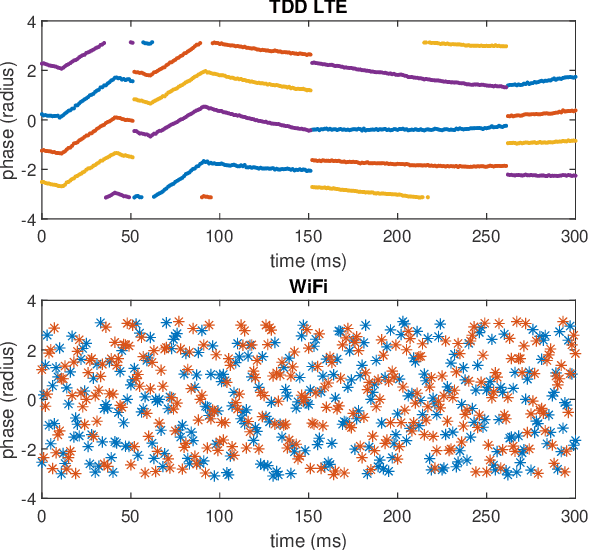
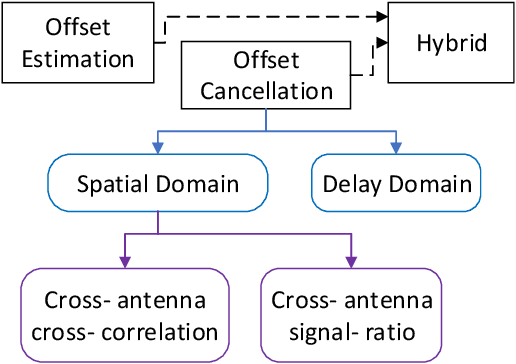
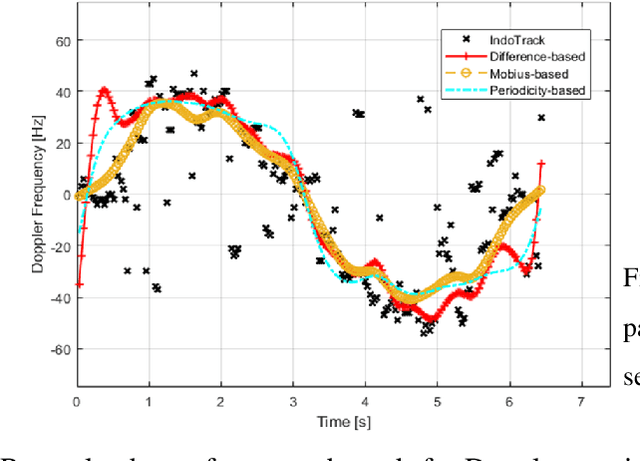

Abstract:Integrated Sensing and Communications (ISAC) has been identified as a pillar usage scenario for the impending 6G era. Bi-static sensing, a major type of sensing in \ac{isac}, is promising to expedite ISAC in the near future, as it requires minimal changes to the existing network infrastructure. However, a critical challenge for bi-static sensing is clock asynchronism due to the use of different clocks at far separated transmitter and receiver. This causes the received signal to be affected by time-varying random phase offsets, severely degrading, or even failing, direct sensing. Considerable research attention has been directed toward addressing the clock asynchronism issue in bi-static sensing. In this white paper, we endeavor to fill the gap by providing an overview of the issue and existing techniques developed in an ISAC background. Based on the review and comparison, we also draw insights into the future research directions and open problems, aiming to nurture the maturation of bi-static sensing in ISAC.
Learned Spike Encoding of the Channel Response for Low-Power Environment Sensing
Jan 29, 2024



Abstract:Radio Frequency (RF) sensing holds the potential for enabling pervasive monitoring applications. However, modern sensing algorithms imply complex operations, which clash with the energy-constrained nature of edge sensing devices. This calls for the development of new processing and learning techniques that can strike a suitable balance between performance and energy efficiency. Spiking Neural Networks (SNNs) have recently emerged as an energy-efficient alternative to conventional neural networks for edge computing applications. They process information in the form of sparse binary spike trains, thus potentially reducing energy consumption by several orders of magnitude. Their fruitful use for RF signal processing critically depends on the representation of RF signals in the form of spike signals. We underline that existing spike encoding algorithms to do so generally produce inaccurate signal representations and dense (i.e., inefficient) spike trains. In this work, we propose a lightweight neural architecture that learns a tailored spike encoding representations of RF channel responses by jointly reconstructing the input and its spectral content. By leveraging a tunable regularization term, our approach enables fine-grained control over the performance-energy trade-off of the system. Our numerical results show that the proposed method outperforms existing encoding algorithms in terms of reconstruction error and sparsity of the obtained spike encodings.
VREM-FL: Mobility-Aware Computation-Scheduling Co-Design for Vehicular Federated Learning
Nov 30, 2023Abstract:Assisted and autonomous driving are rapidly gaining momentum, and will soon become a reality. Among their key enablers, artificial intelligence and machine learning are expected to play a prominent role, also thanks to the massive amount of data that smart vehicles will collect from their onboard sensors. In this domain, federated learning is one of the most effective and promising techniques for training global machine learning models, while preserving data privacy at the vehicles and optimizing communications resource usage. In this work, we propose VREM-FL, a computation-scheduling co-design for vehicular federated learning that leverages mobility of vehicles in conjunction with estimated 5G radio environment maps. VREM-FL jointly optimizes the global model learned at the server while wisely allocating communication resources. This is achieved by orchestrating local computations at the vehicles in conjunction with the transmission of their local model updates in an adaptive and predictive fashion, by exploiting radio channel maps. The proposed algorithm can be tuned to trade model training time for radio resource usage. Experimental results demonstrate the efficacy of utilizing radio maps. VREM-FL outperforms literature benchmarks for both a linear regression model (learning time reduced by 28%) and a deep neural network for a semantic image segmentation task (doubling the number of model updates within the same time window).
An Experimental Prototype for Multistatic Asynchronous ISAC
Oct 01, 2023Abstract:We prototype and validate a multistatic mmWave ISAC system based on IEEE802.11ay. Compensation of the clock asynchrony between each TX and RX pair is performed using the sole LoS wireless signal propagation. As a result, our system provides concurrent target tracking and micro-Doppler estimation from multiple points of view, paving the way for practical multistatic data fusion. Our results on human movement sensing, complemented with precise, quantitative GT data, demonstrate the enhanced sensing capabilities of multistatic ISAC, due to the spatial diversity of the receiver nodes.
 Add to Chrome
Add to Chrome Add to Firefox
Add to Firefox Add to Edge
Add to Edge